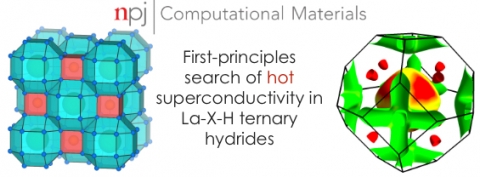First-principles search of hot superconductivity in La-X-H ternary hydrides

Superhydrides are hydrogen-rich materials which form under pressures of over a million atmospheres. Among them are the superconductors with the highest recorded critical temperatures (H3S, LaH10), and recently even above room temperature (C-S-H). A lot of these successes are owed to the successful synergy of experiments and computational predictions. These have dramatically accelerated the rate of discoveries by allowing the simulation of all the materials properties, completely in silico, with unprecedented accuracy.
Motivated by a recent experimental claim of hot superconductivity with critical temperatures up to 550 K in La + x hydrides, we investigated the high-pressure phase diagram of compounds that may have formed in the experiment, using first-principles calculations for evolutionary crystal structure prediction and superconductivity.
Starting from the hypothesis that the observed Tc may be realized by successive heating upon a pre-formed LaH10 phase, we examine plausible ternaries of lanthanum, hydrogen and other elements present in the diamond anvil cell: boron, nitrogen, carbon, platinum, gallium, gold. We find that only boron and, to a lesser extent, gallium form metastable superhydride-like structures that can host high-Tc superconductivity, but the predicted Tc’s are incompatible with the experimental reports.
Our results indicate that, while the claims of hot superconductivity should be reconsidered, it is very likely that unknown H-rich ternary or multinary phases containing lanthanum, hydrogen, and possibly boron or gallium may have formed under the reported experimental conditions, and that these may exhibit superconducting properties comparable, or even superior, to those of currently known hydrides.
Authors:
Simone Di Cataldo, Wolfgang von der Linden, Lilia Boeri
Reference:
NPJ: Computational Materials
